A Selection of eDNA Publications
Please note this collection is not exhaustive, and there are many eDNA publications world-wide. If you would like to add your own paper or have other publication suggestions, please fill out the Publication Submission form at the bottom of the page.
Publications featuring community authors
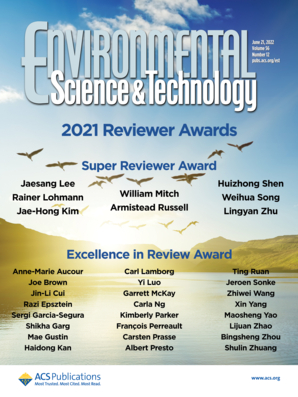
Temperature Controls eDNA Persistence across Physicochemical Conditions in Seawater
- (McCartin et al, 2022,
- Environmental Science & Technology)
Environmental DNA (eDNA) quantification and sequencing are emerging techniques for assessing biodiversity in marine ecosystems. Environmental DNA can be transported by ocean currents and may remain at detectable concentrations far from its source depending on how long it persists. Thus, predicting the persistence time of eDNA is crucial to defining the spatial context of the information derived from it. To investigate the physicochemical controls of eDNA persistence, we performed degradation experiments at temperature, pH, and oxygen conditions relevant to the open ocean and the deep sea.
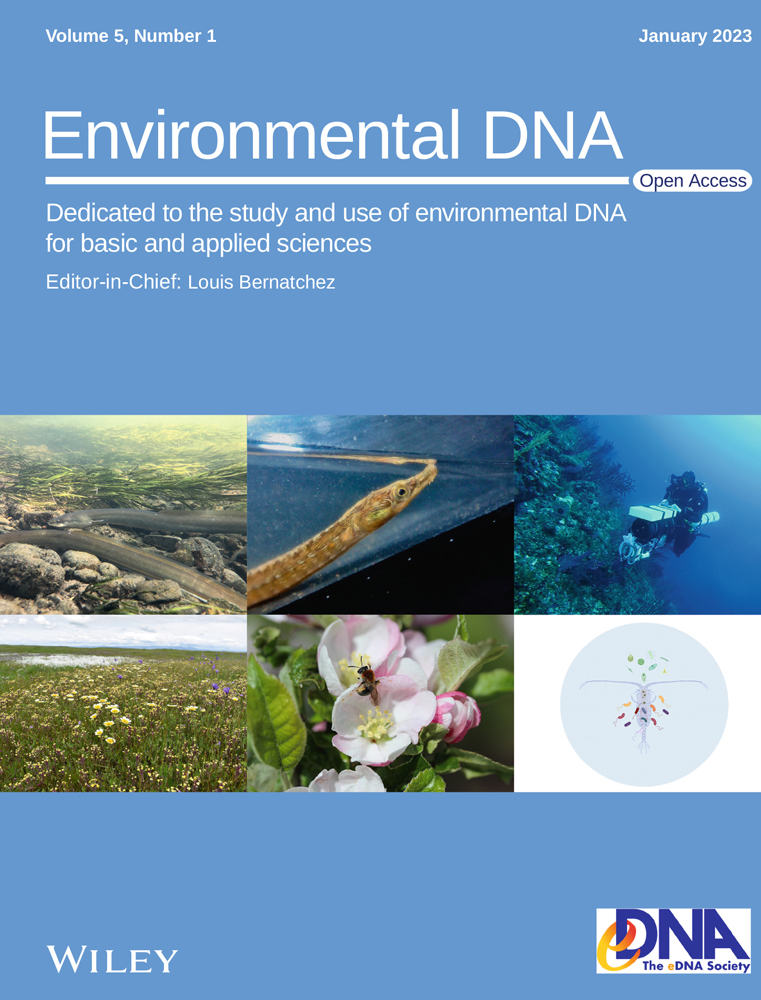
Environmental DNA surveys of African biodiversity: State of knowledge, challenges, and opportunities
- (von der Heyden et al., 2022,
- Environmental DNA)
Environmental DNA surveys have become a well-established tool for detecting natural communities, showing excellent promise for supporting biodiversity monitoring, conservation, and management efforts. Africa is a continent of exceptional biodiversity, threatened not only by anthropogenic pressures but also by a general lack of research capacity and infrastructure, limiting evaluation and monitoring of ecosystems. This commentary explores the use of environmental DNA in surveying natural diversity, a rapidly moving field, within the context of capturing Africa’s natural capital.

Environmental DNA (eDNA): Powerful technique for biodiversity conservation
- (Sahu et al., 2023,
- Journal for Nature Conservation)
Environmental DNA (eDNA) metabarcoding is a non-invasive method for discovering and identifying rare and endangered species in a variety of ecosystems, including aquatic environments, based on the retrieval of genetic traces emitted into the environment by animals. Environmental (e) DNA research has grown in popularity over the last decade as a result of a rise in the number of studies that employ DNA taken from the environment, particularly in freshwater and marine ecosystems. In terms of detecting diversity patterns, we may claim that DNA retrieved from the environment (eDNA) is altering the game. For resource management in fisheries, information on species composition and biomass/abundance of commercially and noncommercially harvested species is critical. The eDNA is a truly non-invasive method that inflicts no damage on the species or habitats under study even during sampling, the eDNA technique never harms any ecosystems or threatened species. This novel molecular method never affects any endangered species or ecosystem during sampling. Environmental DNA analysis has become more widely accepted and is used in the detection of the presence and absence of aquatic macrofauna, such as freshwater and marine fish. This review study may aid researchers in better understanding the current state of eDNA technology. Despite the fact that various scientists have used eDNA to investigate the worldwide biodiversity of aquatic environments, no one in India is focusing on this new technology. We conclude that the eDNA technique has the potential to become a next-generation tool for biodiversity research and aquatic ecosystem conservation.
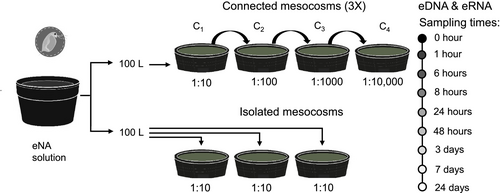
Comparative Decay Dynamics and Detectability of eDNA and eRNA in Connected and Isolated Freshwater Mesocosms Using Digital PCR
- (Morgado-Gamero, W. B., Tournayre, O., Cristescu, M. E. ,
- Molecular Ecology Resources)
Efficient use of environmental nucleic acids (eNAs) in freshwater biodiversity monitoring requires understanding their degradation and detectability in interconnected ecosystems. We employed a novel field-scale assay to compare environmental DNA (eDNA) and environmental RNA (eRNA) decay rates and detectability across four genetic markers (16S, 18S, COI and LDHA) in connected and isolated 1000-L mesocosms containing natural planktonic assemblages. This design provides ecologically relevant and complex settings to assess how connectivity influences the detectability of eNA over time. Isolated and head mesocosms were spiked with eNAs from cultured Daphnia pulex, absent from the water source, while downstream mesocosms received eNAs via unidirectional water transfers. Using digital PCR (dPCR), we captured fine-scale temporal patterns across mitochondrial and nuclear markers and transcript types (mRNA and rRNA), an approach rarely combined in previous research. eRNA degraded significantly faster than eDNA across markers and mesocosm types. Among RNA types, mRNA (COI, LDHA) degraded faster than rRNA (16S, 18S). eRNA followed a uniform monophasic decay pattern, whereas eDNA displayed biphasic decay for nuclear markers and monophasic decay for mitochondrial markers. eNA decay rates in this field-relevant mesocosm network exceeded those from laboratory scale. While decay rates remained consistent across networks, detectability declined with dilution. Even after a 10,000-fold dilution, both eNAs were detected in terminal mesocosms, demonstrating effective transport across the network. Although RNA degrades rapidly, high detectability was achieved across diverse dilutions using dPCR, highlighting eRNA’s potential for detecting active biological communities in freshwater systems.
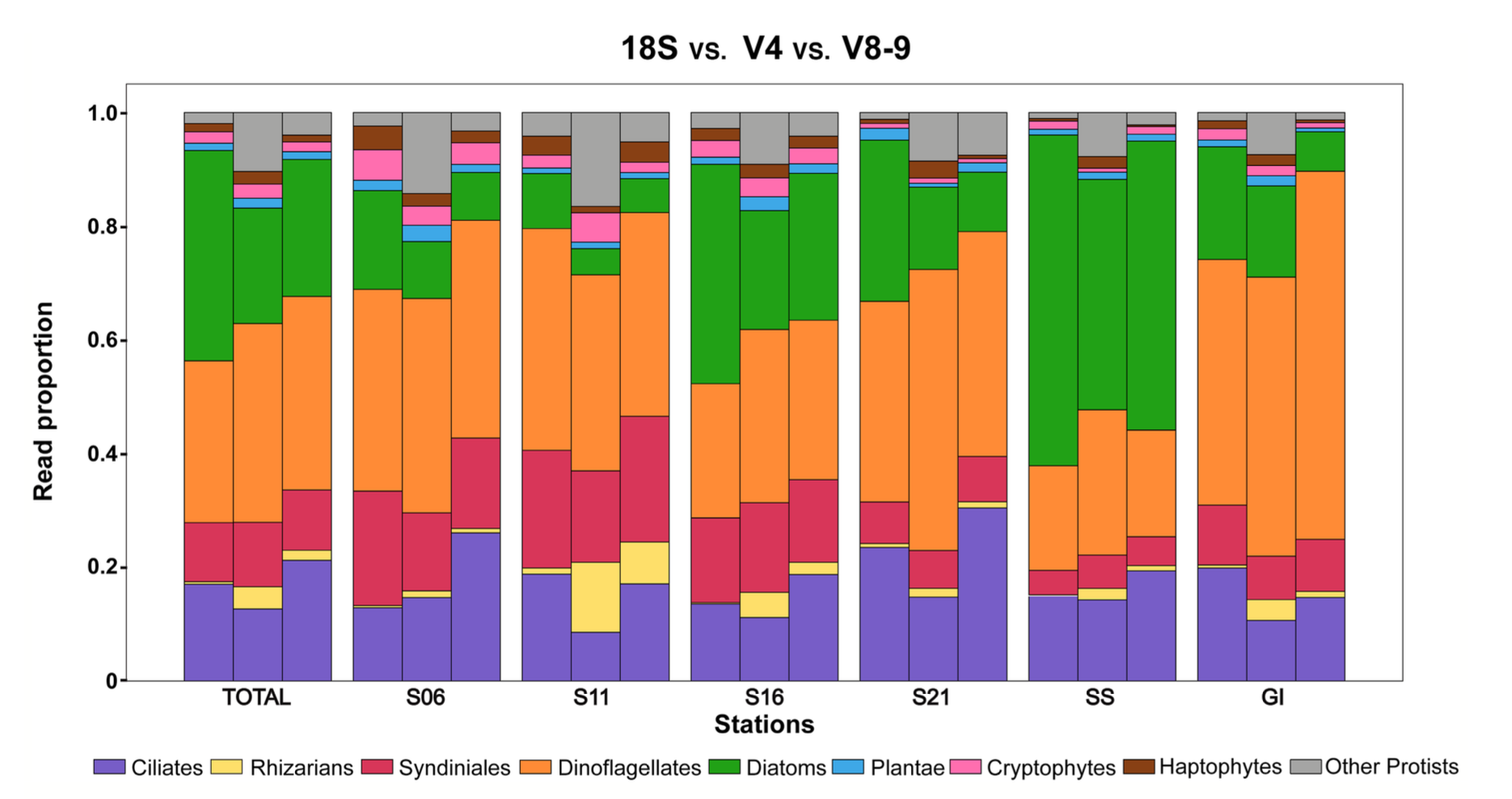
A full-length 18S ribosomal DNA metabarcoding approach for determining protist community diversity using Nanopore sequencing
- (Gaonkar, C. G., Campbell, L. ,
- Ecology and Evolution)
Efficient use of environmental nucleic acids (eNAs) in freshwater biodiversity monitoring requires understanding their degradation and detectability in interconnected ecosystems. We employed a novel field-scale assay to compare environmental DNA (eDNA) and environmental RNA (eRNA) decay rates and detectability across four genetic markers (16S, 18S, COI and LDHA) in connected and isolated 1000-L mesocosms containing natural planktonic assemblages. This design provides ecologically relevant and complex settings to assess how connectivity influences the detectability of eNA over time. Isolated and head mesocosms were spiked with eNAs from cultured Daphnia pulex, absent from the water source, while downstream mesocosms received eNAs via unidirectional water transfers. Using digital PCR (dPCR), we captured fine-scale temporal patterns across mitochondrial and nuclear markers and transcript types (mRNA and rRNA), an approach rarely combined in previous research. eRNA degraded significantly faster than eDNA across markers and mesocosm types. Among RNA types, mRNA (COI, LDHA) degraded faster than rRNA (16S, 18S). eRNA followed a uniform monophasic decay pattern, whereas eDNA displayed biphasic decay for nuclear markers and monophasic decay for mitochondrial markers. eNA decay rates in this field-relevant mesocosm network exceeded those from laboratory scale. While decay rates remained consistent across networks, detectability declined with dilution. Even after a 10,000-fold dilution, both eNAs were detected in terminal mesocosms, demonstrating effective transport across the network. Although RNA degrades rapidly, high detectability was achieved across diverse dilutions using dPCR, highlighting eRNA’s potential for detecting active biological communities in freshwater systems.
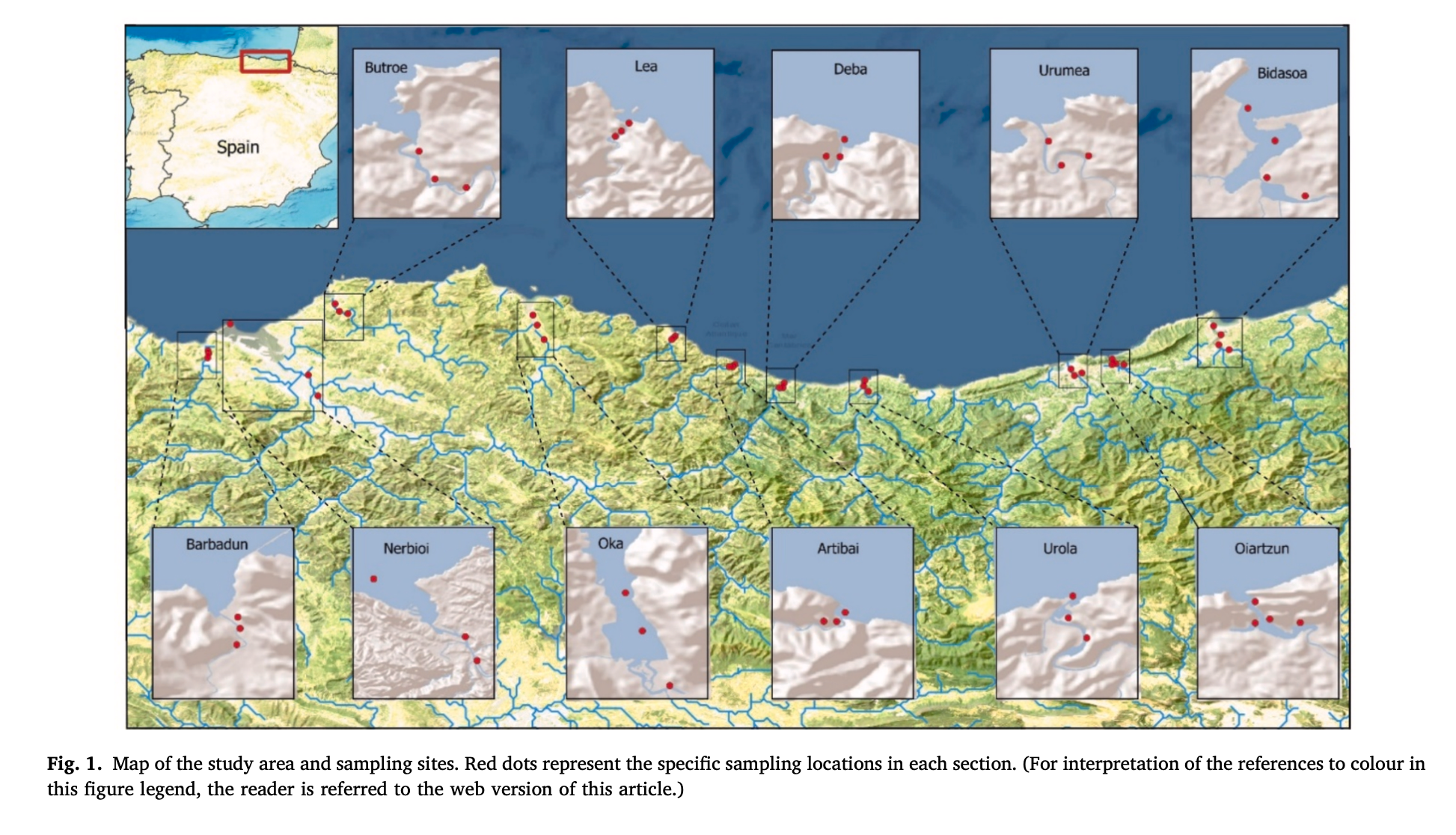
Advancing ecological assessment: towards the integration of eDNA
- (Bhendarkar, M., Canals, O., Jurado, C., Mendibil, I., Uriarte, A., Borja, A., Rodríguez-Ezpeleta, N.,
- Ecological Indicators)
In the face of increasing anthropogenic pressures on estuarine ecosystems, methods to efficiently and reliably assess their ecological status are essential. This study explores the integration of environmental DNA analysis into the AZTI’s Fish Index (AFI) to assess ecological status of estuarine ecosystems. Surface water eDNA sampling and bottom trawl surveys were performed across multiple estuaries in the Basque Country, Spain, and resulting species data were used to calculate AFI scores. eDNA metabarcoding consistently detected higher fish species richness than bottom trawling, while the latter remained more effective at capturing demersal species. In general, ecological classifications from eDNA- and bottom trawl derived data displayed low concordance, largely due to differing species assemblages and metric contributions. These results emphasize the respective strengths and weaknesses of each methodology and the necessity for method-specific calibration. Considering that the AFI is calibrated using bottom trawl data, its direct application to eDNA-derived species lists may lead to some inconsistencies. This study underscores the critical necessity to establish eDNA-specific reference conditions and to recalibrate index thresholds accordingly. While eDNA approach may not entirely replace traditional methods, its scalability, sensitivity, and minimal ecological disturbances establish it as an essential complementary application within monitoring programs. This research strongly supports the urgent advancement of eDNA-based indices and the critical enhancement of reference conditions for their effective incorporation into ecological assessment frameworks under the Water Framework Directive.
Publications featuring eDNA Collaborative authors
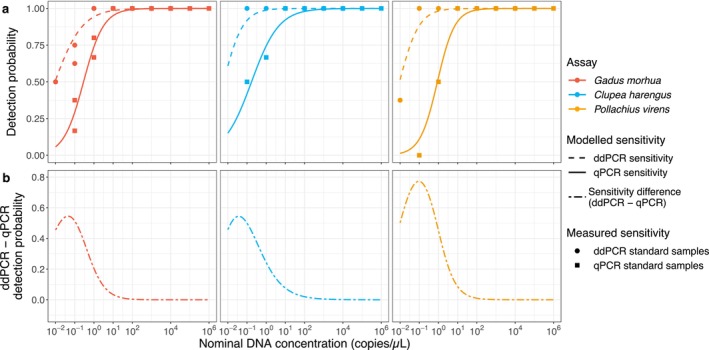
Quantifying the Detection Sensitivity and Precision of qPCR and ddPCR Mechanisms for eDNA Samples
- (Guri, G., Ray, J.L., Shelton, A.O., Kelly, R.P., Præbel, K., Andruszkiewicz Allan, E., Yoccoz, N., Johansen, T., Wangensteen, O.S., Hanebrekke, T. and Westgaard, J.-I.,
- 2024, Ecol Evol)
Environmental DNA (eDNA) detection employing quantitative PCR (qPCR) and droplet digital PCR (ddPCR) offers a non-invasive and efficient approach for monitoring aquatic organisms. Accurate and sensitive quantification of eDNA is crucial for tracking rare and invasive species and understanding the biodiversity abundance and distribution of aquatic organisms. This study compares the sensitivity and quantification precision of qPCR and ddPCR for eDNA surveys through Bayesian inference using latent parameters from both known concentration (standards) and environmental samples across three teleost fish species assays. The results show that ddPCR offers higher sensitivity and quantification precision, particularly at low DNA concentrations (< 1 copy/μL reaction), than qPCR. These findings highlight the superior performance of ddPCR for eDNA detection at low concentrations, guiding researchers towards more reliable methods for effective species monitoring. Additionally, this study indicates that a two-step (detection and concentration) model increased the precision of qPCR results, useful for enhancing the robustness of eDNA quantification. Furthermore, we investigated the lower limit of quantification for ddPCR, providing insights on how such limit can be extended, which could also be applied to qPCR.

Adoption of environmental DNA in public agency practice
- (Lee et al, 2023,
- Environmental DNA)
Environmental DNA (eDNA) analysis has matured to the point that it is ready for deployment in many applications, particularly in aquatic environments. But public agencies have yet to adopt eDNA methods into their environmental decision making routines at scale, even when eDNA offers clear advantages to those now in use. This article provides a perspective on this gap by considering adoption of a new technology as a path-dependent, social process in which some paths lead to outcomes that provide far greater benefits than others.
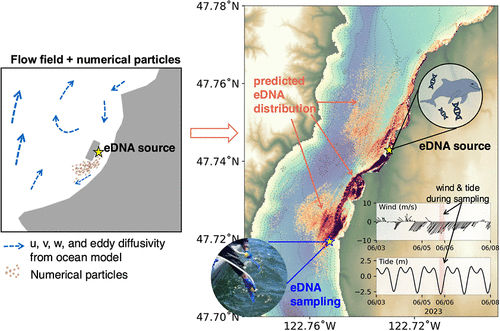
Advective Transport Drives Environmental DNA Dispersal in an Estuary
- (Xiong, J., MacCready, P., Brasseale, E., Andruszkiewicz Allan, E, Ramón-Laca, A., Parsons, K. M., Shaffer, M., Kelly, R. P.,
- 2025, Environmental Science & Technology)
Environmental DNA (eDNA) is increasingly used for species detection and biodiversity monitoring in estuary and marine environments. The dynamic nature of these environments affects eDNA distribution relative to its source organisms, complicating the interpretation of eDNA observations and challenging the field sampling design. Here, an eDNA fate and transport model, built on an ocean model with Lagrangian particle tracking, provided a spatiotemporal estimate of the rapidly diluted eDNA shed by rare targets in an estuary environment before sampling. Based on the predicted particle densities, over 70% of the preselected stations detected the target eDNA. Despite potential variations in source strength and patchy distributions, the model explained approximately 40% of the observed variation in eDNA abundance; by comparison, eDNA concentration was uncorrelated with straight-line distance from the source or with a simplified oceanographic model. Our study revealed the extent of advective transport in shaping eDNA distribution and abundance and demonstrated the utility of ocean models and particle tracking in integrating marine eDNA observations with degradation, transport, and dilution processes; thus, it suggests broader applications to enhance understanding of eDNA signals and dispersal and optimize sampling strategies in other estuarine or marine environments.
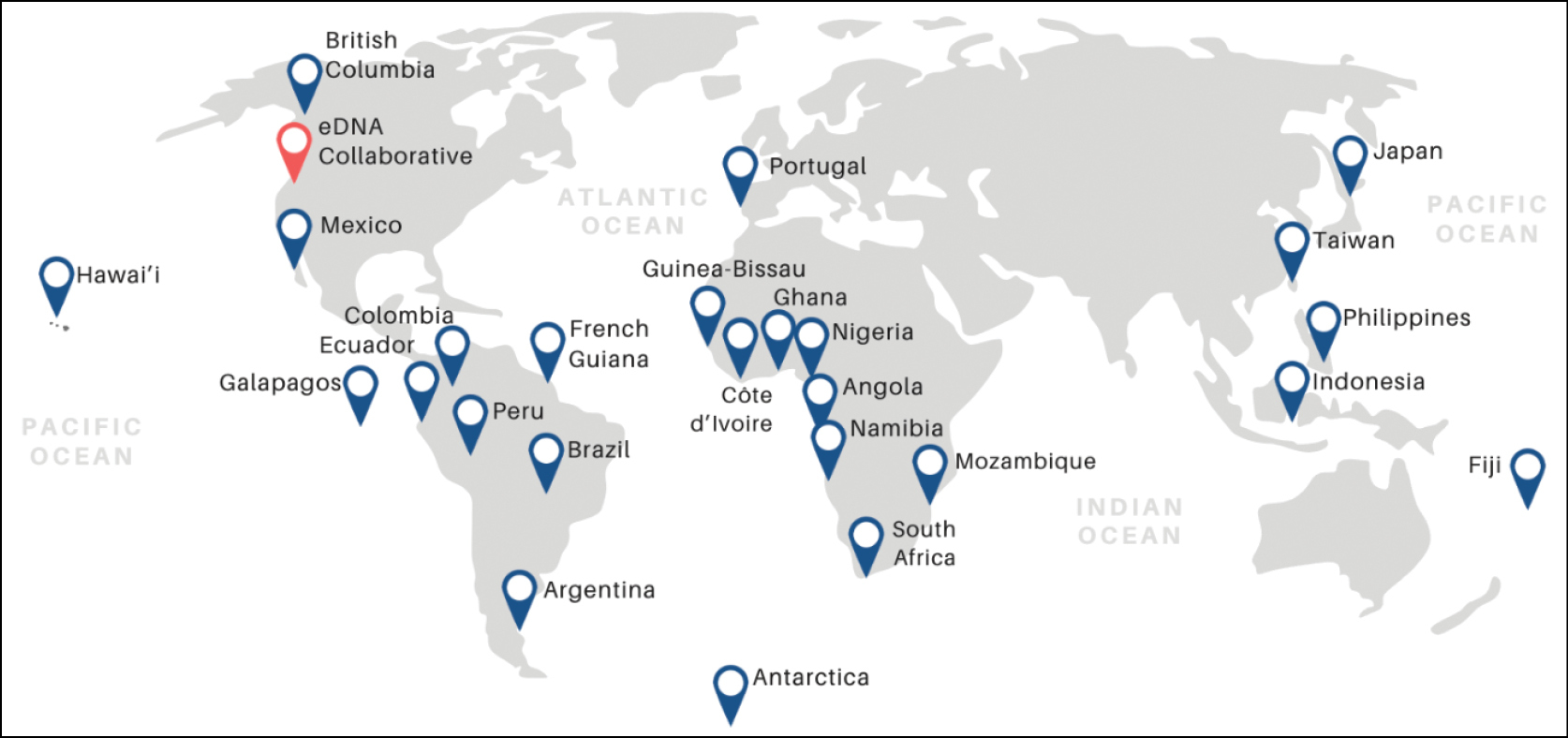
Centering accessibility, increasing capacity, and fostering innovation in the development of international eDNA standards
- (Hirsch et al., 2023,
- Metabarcoding and Metagenomics)

Critical considerations for communicating environmental DNA science
- (Stein et al, 2023,
- Environmental DNA)
The economic and methodological efficiencies of environmental DNA (eDNA) based survey approaches provide an unprecedented opportunity to assess and monitor aquatic environments. However, instances of inadequate communication from the scientific community about confidence levels, knowledge gaps, reliability, and appropriate parameters of eDNA-based methods have hindered their uptake in environmental monitoring programs and, in some cases, has created misperceptions or doubts in the management community. To help remedy this situation, scientists convened a session at the Second National Marine eDNA Workshop to discuss strategies for improving communications with managers.
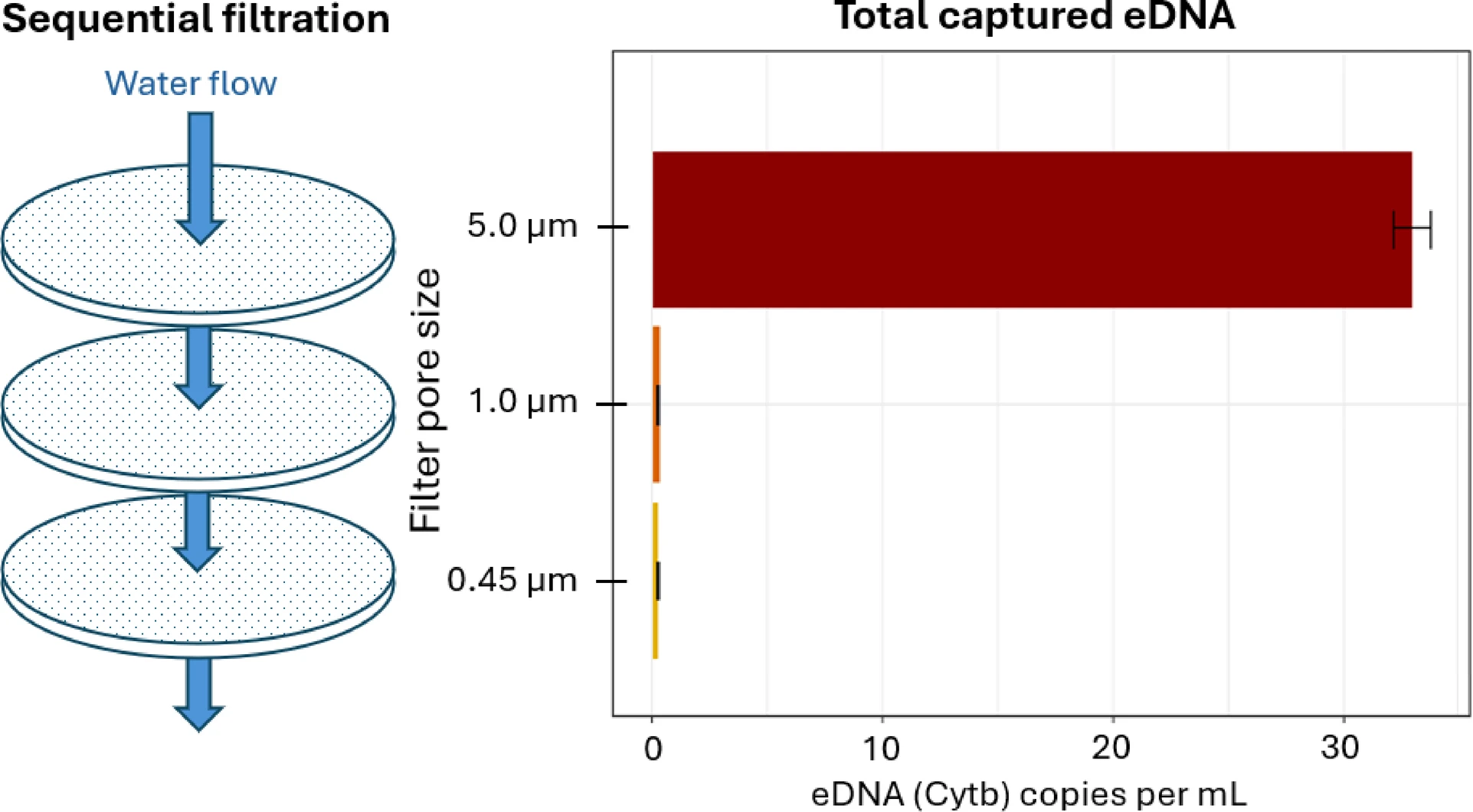
Differential decay of multiple environmental nucleic acid components
- (Brandão-Dias, P.F., Shaffer, M., Guri, G. et al.,
- 2025, Sci Rep)
Detections of environmental nucleic acids (eNA), such as DNA and RNA, are powerful tools for monitoring biodiversity. Yet, precise interpretation of these indirect detections requires understanding of eNAs persistence. We conducted a decay experiment to track degradation of six eNA components derived from the bottlenose dolphin Tursiops truncatus: mitochondrial eDNA of varying lengths, ribosomal eRNA, and messenger eRNA. Target eNAs were quantified over seven days via digital droplet PCR (ddPCR). Decay followed a biphasic exponential model with rapid initial loss (~ 24 h at 15 °C), followed by slower degradation. Mitochondrial messenger eRNA was least stable, disappearing within four hours. Ribosomal eRNA persisted longer but degraded slightly faster than its eDNA counterpart (decay rate λ₁ = 0.236 vs. 0.165 h⁻¹). Longest eDNA fragments decayed more rapidly (λ₁ = 0.190 h−1) than shorter ones (λ₁ = 0.114 h−1). These findings support using eDNA fragment length as a proxy for degradation and reinforce that combining multiple eNA components with distinct stabilities can provide a molecular clock to infer eNA age. This approach improves the spatiotemporal resolution of eNA-based monitoring, particularly for rare cetaceans that act as point sources. We also emphasize the importance of explicitly distinguishing between RNA types (ribosomal vs. messenger) in environmental studies, given their divergent stability and interpretability.
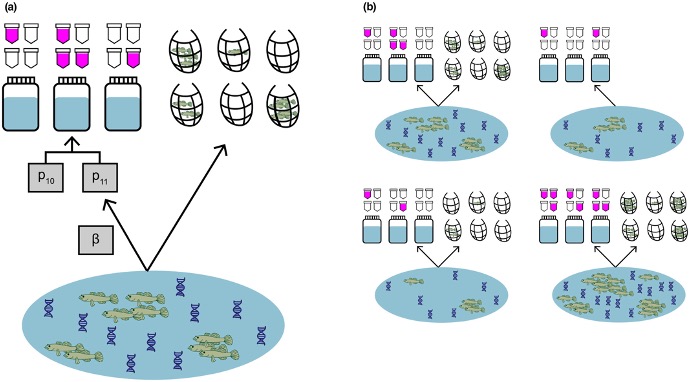
eDNAjoint: An R package for interpreting paired or semi-paired environmental DNA and traditional survey data in a Bayesian framework
- (Keller, A. G., & Kelly, R. P. ,
- 2025, Methods in Ecology and Evolution)
Environmental DNA (eDNA) sampling is increasingly used in surveys of species distribution as a potentially sensitive and efficient monitoring method. Yet access to modelling tools designed specifically for interpreting this new data type lags behind its ubiquity. While occupancy modelling software has dominated the analytical landscape for eDNA data analysis of single species, this type of model may not always be the most appropriate. The rate of eDNA detection often corresponds to species density, rather than just occupancy, and researchers often have access to observations from non‐genetic sampling methods at the same sites.
To provide users access to a modelling framework designed to maximize the use of all available data, we developed an R package, eDNAjoint . The package provides an easy‐to‐use interface for fitting a ‘joint’ model that integrates data from paired or semi‐paired eDNA and traditional surveys in a Bayesian framework. The model can be used to estimate parameters like the probability of a false positive eDNA detection and mean catch rate at a site, and the package allows access to multiple model variations and Bayesian prior customization. Additional functionality can be used for model selection, summarising posteriors and comparing the relative sensitivities of the two survey methods.
We demonstrate the use of eDNAjoint by fitting a variation of the model with site‐level covariates that scale the sensitivity of eDNA sampling relative to traditional sampling. The example workflow uses binary eDNA and seine count data for the endangered tidewater goby ( Eucyclogobius newberryi ) from a study by Schmelzle and Kinziger (2016). This use case includes a prior sensitivity analysis and an evaluation of the relationship between detection rates and environmental variables.
eDNAjoint has the potential to greatly increase the range of users who will be able to rigorously analyse eDNA and traditional survey data in a Bayesian framework, understand if and how eDNA can improve monitoring practices, and gain confidence in the interpretability of eDNA data.

Environmental DNA provides quantitative estimates of Pacific hake abundance and distribution in the open ocean
- (Shelton et al. 2022,
- Proceedings of the Royal Society B, Biological Sciences)
We sampled eDNA in parallel with a traditional acoustic-trawl survey to assess the value of eDNA surveys at a scale relevant to fisheries management. Despite local differences, the two methods yield comparable information about the broad-scale spatial distribution and abundance. Furthermore, we find depth and spatial patterns of eDNA closely correspond to acoustic-trawl estimates for hake. We demonstrate the power and efficacy of eDNA sampling for estimating abundance and distribution and move the analysis of eDNA data beyond sample-to-sample comparisons to management relevant scales. We posit that eDNA methods are capable of providing general quantitative applications that will prove especially valuable in data-or resource-limited contexts.
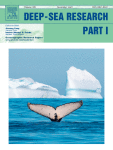
Improved biodiversity detection using a large-volume environmental DNA sampler with in situ filtration and implications for marine eDNA sampling strategies
- (Govindarajan et al, 2022,
- Deep Sea Research Part I: Oceanographic Research)
Metabarcoding analysis of environmental DNA samples is a promising new tool for marine biodiversity and conservation. Typically, seawater samples are obtained using Niskin bottles and filtered to collect eDNA. However, standard sample volumes are small relative to the scale of the environment, conventional collection strategies are limited, and the filtration process is time consuming. To overcome these limitations, we developed a new large – volume eDNA sampler with in situ filtration, capable of taking up to 12 samples per deployment.
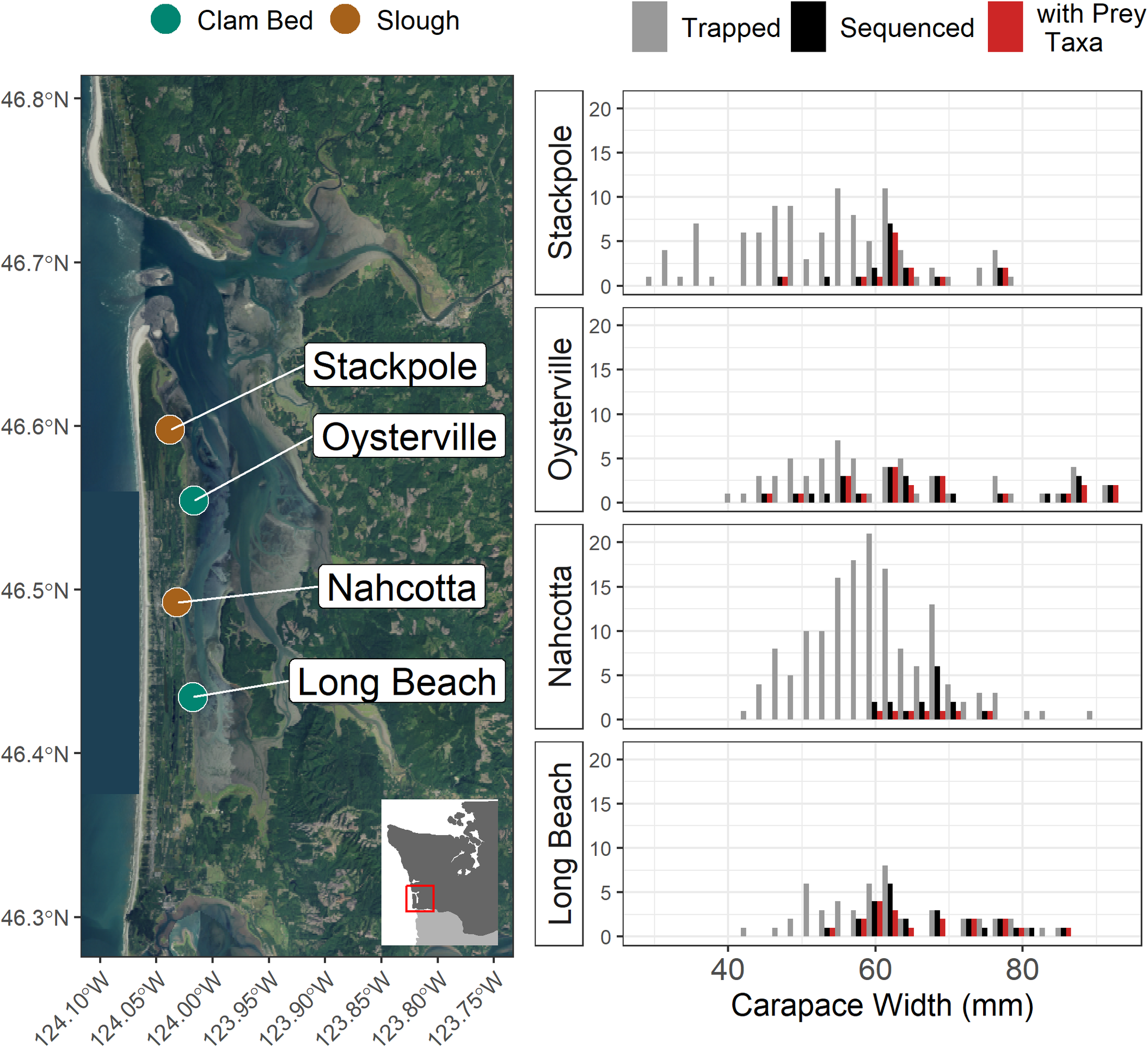
Invasive European green crab (Carcinus maenas) predation in a Washington State estuary revealed with DNA metabarcoding
- (Fisher M.C., Grason E.W., Stote A., Kelly R.P., Litle K., et al.,
- 2024, PLOS ONE)
Predation by invasive species can threaten local ecosystems and economies. The European green crab (Carcinus maenas), one of the most widespread marine invasive species, is an effective predator associated with clam and crab population declines outside of its native range. In the U.S. Pacific Northwest, green crab has recently increased in abundance and expanded its distribution, generating concern for estuarine ecosystems and associated aquaculture production. However, regionally-specific information on the trophic impacts of invasive green crab is very limited. We compared the stomach contents of green crabs collected on clam aquaculture beds versus intertidal sloughs in Willapa Bay, Washington, to provide the first in-depth description of European green crab diet at a particularly crucial time for regional management. We first identified putative prey items using DNA metabarcoding of stomach content samples. We compared diet composition across sites using prey presence/absence and an index of species-specific relative abundance. For eight prey species, we also calibrated metabarcoding data to quantitatively compare DNA abundance between prey taxa, and to describe an ‘average’ green crab diet at an intertidal slough versus a clam aquaculture bed. From the stomach contents of 61 green crabs, we identified 54 unique taxa belonging to nine phyla. The stomach contents of crabs collected from clam aquaculture beds were significantly different from the stomach contents of crabs collected at intertidal sloughs. Across all sites, arthropods were the most frequently detected prey, with the native hairy shore crab (Hemigrapsus oregonensis) the single most common prey item. Of the eight species calibrated with a quantitative model, two ecologically-important native species–the sand shrimp (Crangon franciscorum) and the Pacific staghorn sculpin (Leptocottus armatus)–had the highest average DNA abundance when detected in a stomach content sample. In addition to providing timely information on green crab diet, our research demonstrates the novel application of a recently developed model for more quantitative DNA metabarcoding. This represents another step in the ongoing evolution of DNA-based diet analysis towards producing the quantitative data necessary for modeling invasive species impacts.
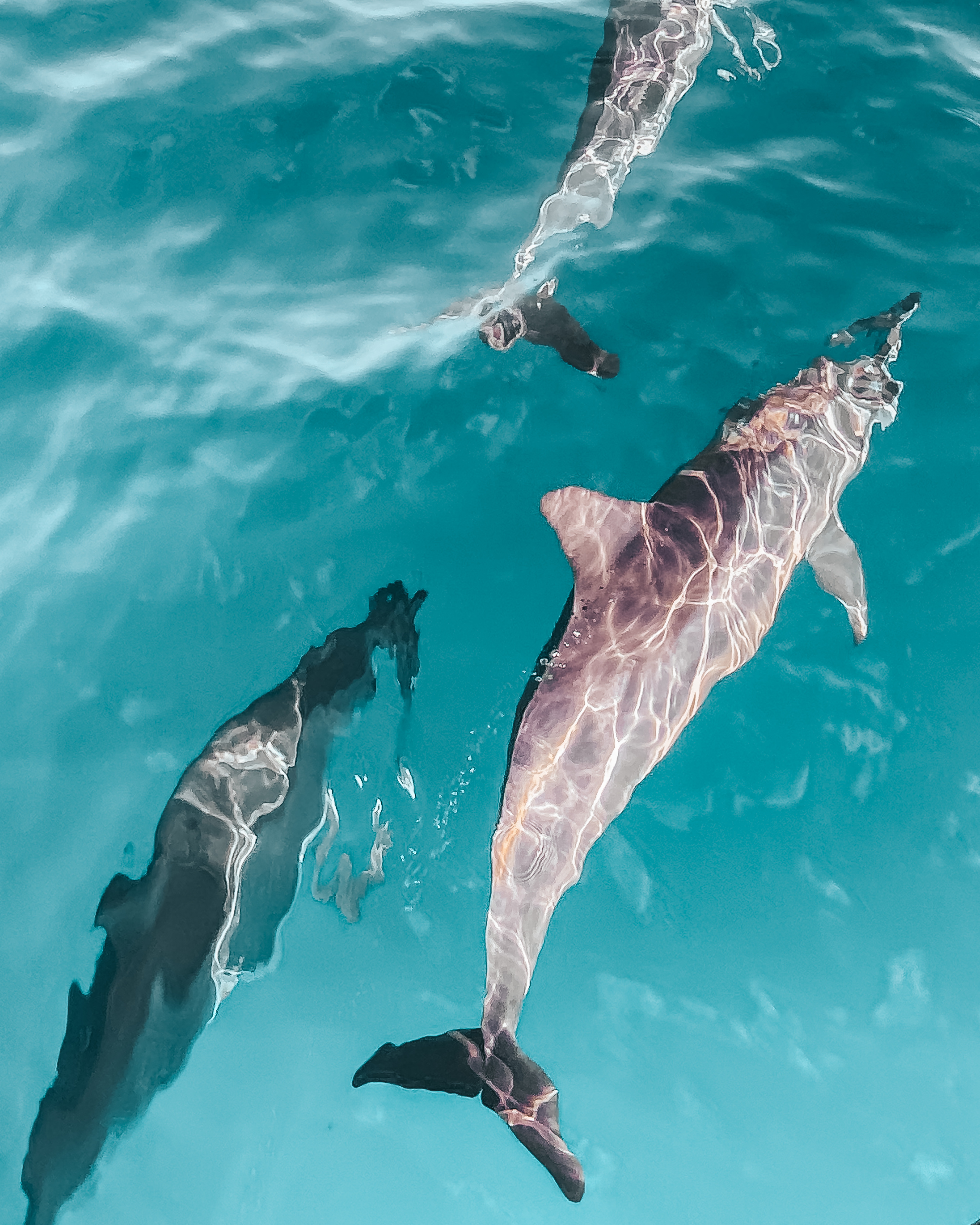
Marine eDNA Production and Loss Mechanisms
- (Brasseale, E., Adams, N., Allan, E. A., Jacobson, E. K., Kelly, R. P., Liu, O. R., et al.,
- 2025, Journal of Geophysical Research: Oceans)
Environmental DNA (eDNA) analysis is a technique for detecting organisms based on genetic material in environments such as air, water, or soil. Observed eDNA concentrations vary in space and time due to biological and environmental processes. Here, we investigate variability in eDNA production and loss by sampling water adjacent to a managed population of non-native cetaceans on a near-hourly timescale for 48 hr. We used diverse sampling approaches and modeling methods to describe time variability in observed eDNA concentrations and then compare the magnitude of production and loss mechanisms. We parsed production and loss in a conceptual box model and compared biological and physical loss rates using a decay experiment and a physical transport-and-diffusion tracer model. We then evaluated eDNA concentrations along a transect away from the animal enclosure in light of model parameter estimates. We conclude that eDNA production is best conceptualized using a time-varying mixed-state model, and biological losses are small relative to physical losses in the marine environment. Because physical loss is unsteady and nonlinear, tracer models are especially helpful tools to estimate it accurately.

Maximizing sampling efficiency to detect differences in fish community composition using environmental DNA metabarcoding in subarctic fjords
- (Guri, G., Westgaard, J.I., Yoccoz, N., Wangensteen, O.S., Præbel, K., Ray, J.L., Kelly, R.P., Shelton, A.O., Hane- brekke, T. and Johansen, T.,
- 2023, Environmental DNA)
Environmental DNA (eDNA) has gained popularity as a tool for ecosystem biomonitoring and biodiversity assessment. Although much progress has been made regarding laboratory and fieldwork protocols, the issue of sampling efficiency requires further investigation, particularly in three-dimensional marine systems. This study focuses on fish community composition in marine ecosystems and aims to analyze the efficiency of sampling design given the sampling effort for distinguishing between different communities. We sampled three fjords in Northern Norway, taking samples along fjord transects and at three different depths, and amplified a fragment of the mitochondrial 12S rRNA gene of bony fishes using the MiFish primers. We evaluated the effect of (i) the number of sampling stations, (ii) samples’ spatial distribution, and (iii) the data treatment approach (presence/absence versus semiquantitative) for maximizing the efficiency of eDNA metabarcoding sampling when inferring differences of fish community compositions between fjords. We found that the manner of data treatment strongly affected the minimum number of sampling stations required to detect differences among communities; because the semiquantitative approach retained some information about abundance of the underlying reads, it was the most efficient. Furthermore, we found little-to-no difference of fish communities in samples from intermediate depths when comparing vertical fish communities. Lastly, we found that the differences between fish communities at the surface were the highest across the horizontal distance and overall, samples ~30 km apart showed the highest variation in the horizontal distribution. Boosting sampling efficiency (reducing sampling effort without compromising ecological inferences) can significantly contribute to enhanced biodiversity management and efficient biomonitoring plans.
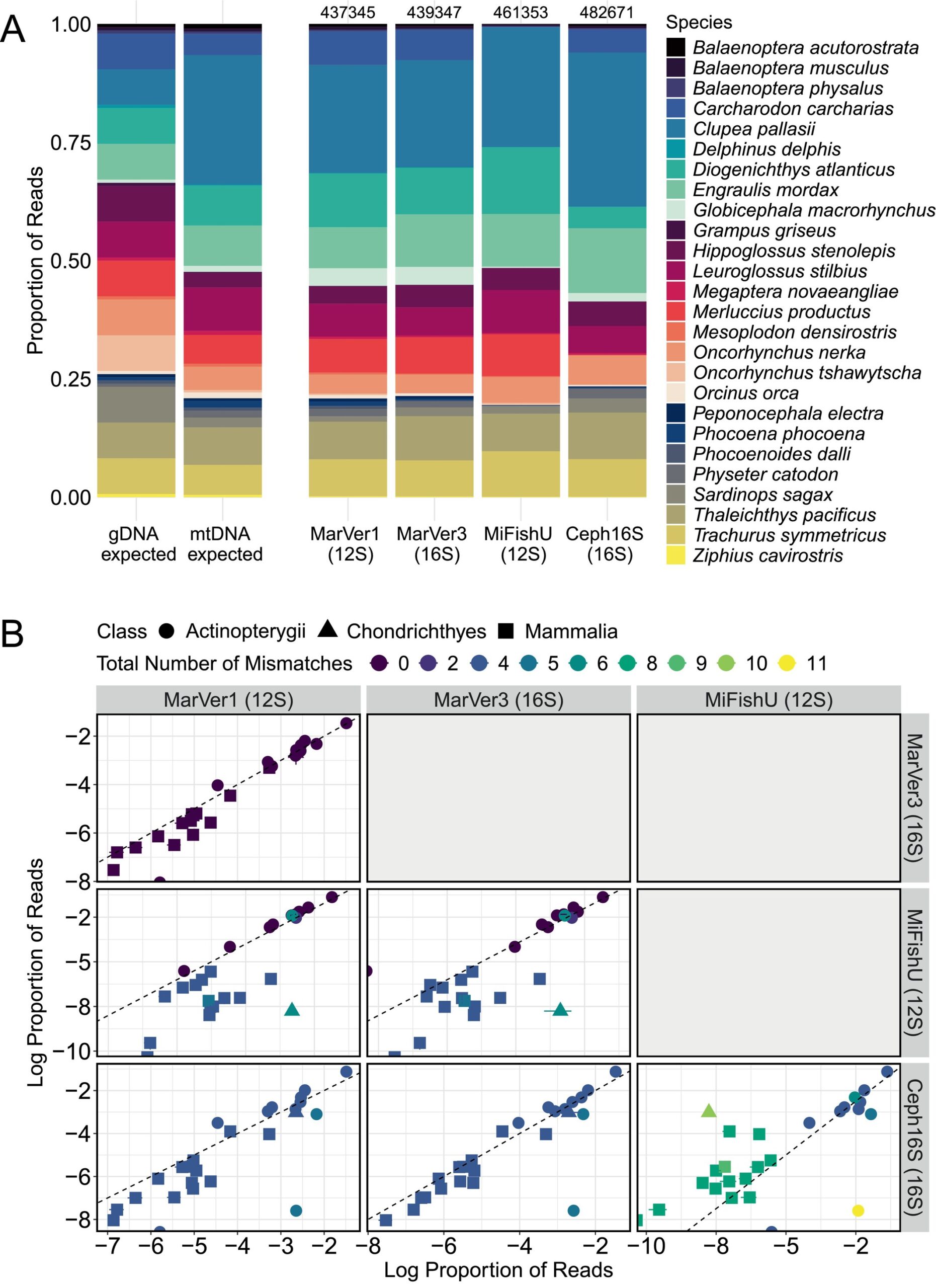
Observation Bias in Metabarcoding
- (Shaffer, M.R., Andruszkiewicz Allan, E., Van Cise, A.M., Parsons, K.M., Shelton, A.O. and Kelly, R.P. ,
- 2025, Mol Ecol Resource)
DNA metabarcoding is subject to observation bias associated with PCR and sequencing, which can result in observed read proportions differing from actual species proportions in the DNA extract. Here, we amplify and sequence a mock community of known composition containing marine fishes and cetaceans using four different primer sets and a variety of PCR conditions. We first compare metabarcoding observations to two different sets of expected species proportions based on total genomic DNA and on target mitochondrial template DNA. We find that calibrating observed read proportions based on template DNA concentration is most appropriate as it isolates PCR amplification bias; calibration with total genomic DNA results in bias that can be attributed to both PCR amplification bias and differing ratios of template to total genomic DNA. We then model the remaining amplification bias and find that approximately 60% can be explained by inherent species-specific DNA characteristics. These include primer-template mismatches, amplicon fragment length, and GC content, which vary somewhat across Taq polymerases. Finally, we investigate how different PCR protocols influence community composition regardless of expected proportions and find that changing protocols most strongly influence the amplification of templates with primer mismatches. Our findings suggest that using primer-template pairs without mismatches and targeting a narrow taxonomic group can yield more repeatable and accurate estimates of species’ true, underlying DNA template proportions. These findings identify key factors that should be considered when designing studies that aim to apply metabarcoding data quantitatively.

Predicting trawl catches using environmental DNA
- (Guri, G., Shelton, A.O., Kelly, R.P., Yoccoz, N., Johansen, T., Præbel, K. Hanebrekke, T., Ray, J.L., Johanna Fall, Westgaard, J.I. ,
- 2024, Genes, ICES Journal of Marine Science)
Quantifying the biomass, or number of individuals, diversity, and distribution of marine species is a critical aspect of understanding and managing marine ecosystems. In recent years, there has been growing interest in using environmental DNA (eDNA) for marine ecosystem management and biodiversity assessment. However, the main challenge hindering eDNA applicability has been the inability to infer absolute species abundances from multispecies analysis (eDNA metabarcoding). In this study, we demonstrate a way forward by estimating the abundance of commercially important fish species in a Norwegian fjord using a joint Bayesian statistical model of traditional trawl-catch data and molecular data derived from eDNA. Using this model, we accurately predict out-of-sample trawl catches using eDNA alone. Moreover, our model provides empirical estimates for key processes linking marine eDNA concentration to the fish population abundance estimated from trawl observations, including trawl catchability, DNA shedding, degradation, dilution, transport, recovery rate, and isolation efficiency. These processes, including amplification efficiencies correcting for Polymerase Chain Reaction (PCR) bias, are species-specific and enable the translation of eDNA metabarcoding data into abundances. These findings have broad implications for the use of eDNA in marine ecosystem management and conservation efforts.

Quantifying impacts of an environmental intervention using environmental DNA
- (Allan et al. 2023,
- Ecological Applications)
Environmental laws around the world require some version of an environmental-impact assessment surrounding construction projects and other discrete instances of human development. Information requirements for these assessments vary by jurisdiction, but nearly all require an analysis of the biological elements of ecosystems. Amplicon-sequencing—also called metabarcoding—of environmental DNA (eDNA) has made it possible to sample and amplify the genetic material of many species present in those environments, providing a tractable, powerful, and increasingly common way of doing environmental-impact analysis for development projects. Here, we analyze an 18-month time series of water samples taken before, during, and after two culvert removals in a salmonid-bearing freshwater stream. We also sampled multiple control streams to develop a robust background expectation against which to evaluate the impact of this discrete environmental intervention in the treatment stream.
Submit Your Publication
The eDNA Collaborative welcomes publication suggestions, yours or someone else’s, for addition to this page. Please submit your suggestion using the form provided. Be sure to include your reason for the recommendation in the “Justification” field.